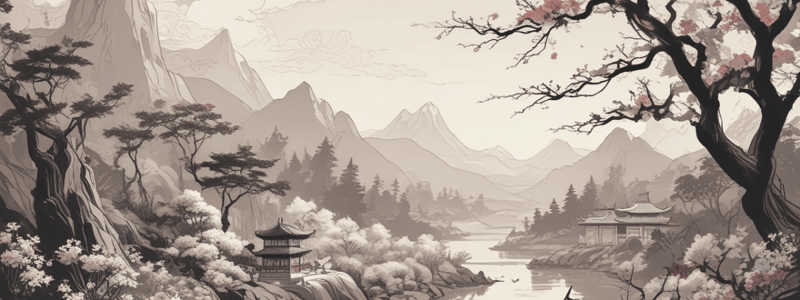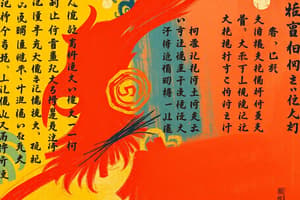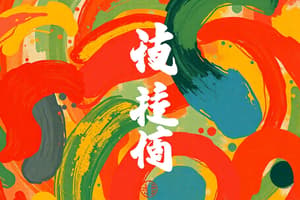Podcast
Questions and Answers
下列哪个诗人创作了诗歌《乌鸦》?
下列哪个诗人创作了诗歌《乌鸦》?
- T.S. Eliot (correct)
- 杜甫
- 李白
- 白居易
什么是文学分析?
什么是文学分析?
- 创建与文学作品主题相关的音乐
- 研究文学作品的背景和作者生平
- 仔细审查文学作品以理解其含义和重要性 (correct)
- 专注于文学作品的销售和市场价值
古典中国诗歌最早起源于哪个朝代?
古典中国诗歌最早起源于哪个朝代?
- 宋朝
- 唐朝 (correct)
- 元朝
- 明朝
古典中国诗歌的特点包括以下哪个方面?
古典中国诗歌的特点包括以下哪个方面?
文学分析可以帮助学生做什么?
文学分析可以帮助学生做什么?
中国古典诗歌中常用的押韵和头韵技巧有时会增强诗歌的音乐性和情感冲击力。
中国古典诗歌中常用的押韵和头韵技巧有时会增强诗歌的音乐性和情感冲击力。
唐朝是中国诗歌的黄金时代,出现了以四个字和八行为特点的诗歌形式。
唐朝是中国诗歌的黄金时代,出现了以四个字和八行为特点的诗歌形式。
古典中国诗歌常常反映自然环境,展示古代中国生活的窗口。
古典中国诗歌常常反映自然环境,展示古代中国生活的窗口。
在中国古典诗歌中,使用了大量的对仗和隐喻来增加诗歌的长度和复杂性。
在中国古典诗歌中,使用了大量的对仗和隐喻来增加诗歌的长度和复杂性。
四字诗和八行诗是现代诗歌中最流行的形式之一。
四字诗和八行诗是现代诗歌中最流行的形式之一。
Flashcards are hidden until you start studying
Study Notes
Poetry: An Exploration of the Written Word
Poetry is a form of literature that uses aesthetic and rhythmic qualities of language to evoke meanings in addition to, or in place of, the prosaic ostensible meaning. It is a rich and diverse genre that has been practiced and celebrated across cultures and throughout history. In this article, we will delve into the world of poetry, exploring its various subtopics including Chinese literature, famous poems, literary analysis, and classical Chinese poetry.
Poetry
Poetry is a versatile and timeless form of literature that has been practiced and celebrated throughout history. It is characterized by its use of language to create vivid images, evoke emotions, and convey ideas. Poetry can take many forms, including sonnets, haikus, free verse, and more. It is often considered a form of artistic expression that requires a unique blend of creativity, skill, and understanding of language.
Chinese Literature
Chinese literature is one of the oldest and most enduring literary traditions in the world. It includes a vast array of genres, including poetry, prose, drama, and more. Chinese poetry is particularly renowned for its beauty, complexity, and depth. Some of the most famous Chinese poets include Li Bai, Du Fu, and Su Shi.
Famous Poems
There are countless famous poems from around the world that have stood the test of time and continue to be celebrated and studied today. Some examples include "The Raven" by Edgar Allan Poe, "The Love Song of J. Alfred Prufrock" by T.S. Eliot, and "The Waste Land" by T.S. Eliot.
Literary Analysis
Literary analysis is the process of closely examining a literary work, such as a poem, in order to understand its meaning and significance. This can involve analyzing the language, structure, themes, and other elements of the work. Literary analysis is often used in academic settings, such as in literature classes, to help students develop a deeper understanding of the literary works they are studying.
Classical Chinese Poetry
Classical Chinese poetry, also known as "classical Chinese verse," is a form of poetry that originated in China and was practiced from the Tang Dynasty (618-907 AD) through the early modern period. It is characterized by its use of traditional poetic forms, such as the five-character line, as well as its focus on nature, human emotion, and the passing of time.
In conclusion, poetry is a rich and diverse literary genre that has been practiced and celebrated throughout history. It is characterized by its use of language to create vivid images, evoke emotions, and convey ideas. Chinese literature, with its focus on poetry, is one of the oldest and most enduring literary traditions in the world. Famous poems from around the world continue to be celebrated and studied today, and literary analysis is an essential tool for understanding and interpreting these works. Finally, classical Chinese poetry is a unique and beautiful form of poetry that is deeply rooted in Chinese culture and tradition.
Studying That Suits You
Use AI to generate personalized quizzes and flashcards to suit your learning preferences.




